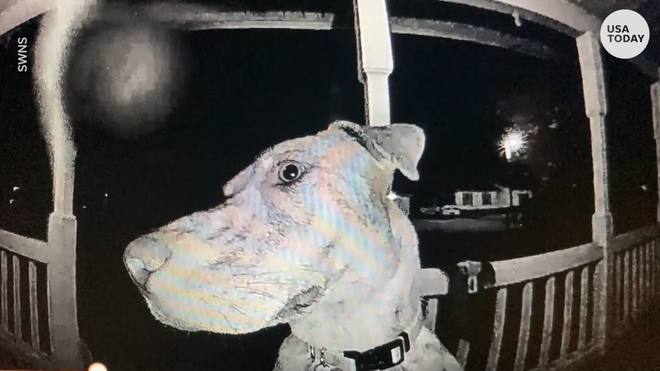
Humans talk about the dog days of summer, evoking a placid lassitude, but for dogs in Florida summer is probably the least easeful of seasons.
“Between the thunderstorms and the heat and the Fourth of July, it is a really stressful time for them,” said Debbi Snyder, owner of DogSense Obedience in Lakeland.
Snyder, who has been training dogs since 1965, said she knows of cases in which dogs, terrified by fireworks on or around July 4, fled their homes and ran away, either to be hit by vehicles or to become lost.
Related:Many animals and people adversely affected by fireworks
Fourth of July:Maya Lora: Polk County says Fourth of July is back and better than ever
“Unfortunately, a lot times it happens they get hit by a car because they’re in panic,” Snyder said. “They’re not thinking clearly. A lot of times, if you see them run and you go out after them and you’re calling them to come, ordinarily a dog that would come when he’s called, they can’t even respond because they’re in too much terror.”
Snyder said she hasn’t noticed any correlation between sizes or breeds of dogs and the tendency to be frightened by loud noises. But she said dogs tend to become more prone to anxiety as they get older.
Of course, it’s impossible to prevent thunderstorms. And annual pleas from veterinarians and others to refrain from lighting off amateur explosives seem to have little effect on human behavior.
But Snyder said dog owners can use some strategies to lessen the fright that many dogs endure in response to thunderstorms and explosives. The options include medications, canine clothing and the creation of perceived safe spaces in the home.
More:Kaboom is back: Lakeland to resume Fourth of July fireworks
Snyder said it isn’t possible to train the anxiety out of a dog. But she said human interventions can help.
Keeping a dog mentally engaged to distract from the sonic assault is one such strategy. For example, starting to play some sort of game or using a tug toy, can reduce the panic, Snyder said.

“Being interactive with their owner is probably the best thing I can think of to help them with their stress, and I don’t mean sitting and the owner stroking them and petting them and saying, ‘It’s OK, darling,’ ” she said. “That’s not what I mean by interactive. I mean, ‘We’ve got this tug toy; let’s play tug’ — that kind of thing.”
Some dogs find comfort in wearing a snug-fitting wraps, such as ThunderShirt products. Owners can put the apparel on their dogs as a thunderstorm approaches or fireworks begin, and the wrap serves as a continual hug, helping to calm the animal.
Snyder said she has had “terrific success” in using such vests with some of her dogs over the years.
She cautions, though, that dogs sense barometric changes and hear distant thunder well before humans do. Once the panic sets in, putting a ThunderShirt on a dog might not be as effective as if it is applied before the fright begins.
Pet health:Old dog syndrome or a brain stroke?
Medication is another option, Snyder said, and veterinarians can prescribe anti-anxiety pills. Edible products infused with CDB — a non-intoxicating element of cannabis plants — have also become popular in recent years.
Heather Moran, owner of the Doggie Bag in Lakeland, can attest to that.
“Of course, right now, with it being thunderstorm and fireworks season and hurricanes, they’re flying off the shelf,” she said.
Moran said CBD-infused treats work well for milder anxiety in dogs or cats, while she recommends faster-acting oils for more severe cases. She said some of the customers recently buying CBD products are dog owners who worked at home during the pandemic and are now returning to their offices, resulting in separation anxiety for their pets.
The drawback with medications and CBD products, Snyder said, is that it takes time between ingestion and the calming effects. And it isn’t always possible to anticipate a thunderstorm.
Opinion:ALL ABOUT PETS: Correct probiotics can help pets
One of Snyder’s six dogs, a mixed breed named Biggs, is particularly frightened by thunder and fireworks. She and her husband keep an open crate that serves as Biggs’ bed, and when loud noises commence he takes shelter in the crate, which serves as his safe place, Snyder said.
Biggs finds such comfort in his crate that he is able to sleep through a thunderstorm, Snyder said.
Moran also suggested creating a place of refuge for a pet.
“People, if they don’t have a kennel, they’ll try to make a cave for the dog and make it dark so they have a place to go,” she said.
Some dogs burrow under a table or desk or hide behind a couch in an attempt to hide from the noise. Snyder said some owners mistakenly think they can soothe their dogs’ distress by taking them out of such a refuge and petting them.
More on pets and storms:Prepare now to care for pets during storms
“The human tendency is to pull them out, and I’ve always found — let them rest back there,” she said. “Yes, they’re terrified, but they’re going to be more terrified if you pull them out.”
Snyder has spent her life seeking closeness with dogs, but she said the sonic distress of summer offers a reminder of the limits on our ability to commune with and comfort animals.
“It’s a difficult situation because there’s not a lot you can do about it,” she said. “It’s not like you can teach them not to be afraid. If they could talk, we could sit down and have a talk with them and say, ‘You’re very safe inside this house; don’t worry about it.’ But we can’t. You can’t do that with a dog.”
Gary White can be reached at gary.white@theledger.com or 863-802-7518. Follow on Twitter @garywhite13.